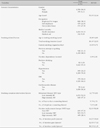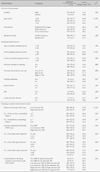Abstract
Purpose
The purpose of this study was to investigate the patterns of smoking relapse and to identify risk factors related to smoking relapse among those successful in smoking cessation at the smoking cessation clinics of public health centers.
Methods
Data were collected from 1,705 six-month quitters and analyzed by the Kaplan-Meier analysis and the Cox proportional hazard model.
Results
The rate of smoking relapse was 38.2% in 1 year, 44.4% in 2 years, and 47.8% in 5 years. The vast majority of relapse (62.3%) occurred within the first six months after quitting. The risk factors related to smoking relapse were age (HR 1.964: 95% CI 1.545, to 2.497), nicotine dependence (HR 1.293: 95% CI 1.087 to 1.539), problem drinking (HR 1.497: 95% CI 1.116 to 2.008), behavioral therapy type (HR 1.398: 95% CI 1.193 to 1.638), and nicotine replacement therapy type (HR 1.363: 95% CI 1.077 to 1.724).
Figures and Tables
References
1. Alterman AI, Gariti P, Mulvaney F. Short- and long-term smoking cessation for three levels of intensity of behavioral treatment. Psychol Addict Behav. 2001; 15(3):261–264.

3. Choi JS. The Effect of Early Detection of Hypertension and Diabetes on Smoking and Alcohol Drinking. Health Soc Welf Rev. 2007; 27(1):103–130.
4. Clavel-Chapelon F, Paoletti C, Benhamou S. Smoking cessation rates 4 years after treatment by nicotine gum and acupuncture. Prev Med. 1997; 26(1):25–28.

5. Doran CM, Valenti L, Robinson M, Britt H, Mattick RP. Smoking status of australian general practice patients and their attempts to quit. Addict Behav. 2006; 31(5):758–766.

6. Ferguson J, Bauld L, Chesterman J, Judge K. The english smoking treatment services: One-year outcomes. Addiction. 2005; 100(Suppl 2):59–69.

7. Gehan EA. A generalized wilcoxon test for comparing arbitrarily singly-censored samples. Biometrika. 1965; 52:203–223.

8. Grandes G, Cortada JM, Arrazola A, Laka JP. Predictors of long-term outcome of a smoking cessation programme in primary care. Br J Gen Pract. 2003; 53(487):101–107.
9. Heatherton TF, Kozlowski LT, Frecker RC. The fagerstrom test for nicotine dependence: A revision of the fagerstrom tolerance questionnaire. Br J Addict. 1991; 86(9):1119–1127.

10. Hughes JR, Keely J, Naud S. Shape of the relapse curve and long-term abstinence among untreated smokers. Addiction. 2004; 99(1):29–38.

11. Hughes JR, Peters EN, Naud S. Relapse to smoking after 1 year of abstinence: A meta-analysis. Addict Behav. 2008; 33(12):1516–1520.
12. Kim MJ, Jeong IS. Smoking relapse and related factors within one year among successes of the smoking cessation clinics of public health centers. J Prev Med Public Health. 2011; 44(2):84–92.

13. Kim SJ, Kwon SM. The social cost of smoking in Korea. Korean J Policy Anal Eval. 2008; 18(4):119–140.
14. Korean Society of Hypertension. Korean hypertension treatment guideline. Seoul: Korean Society of Hypertension;2004.
15. Lee JS, Kang SM, Kim HJ, Lee KY, Cho B, Goh E. Long-term maintenance of smoking cessation and related factors of relapse. Korean J Fam Med. 2009; 30:203–209.

16. Lee KJ, Chang CJ, Kim MS, Lee MH, Cho YH. Factors associated with success of smoking cessation during 6 months. J Korean Acad Nurs. 2006; 36(5):742–750.

17. Levy DT, Romano E, Mumford E. The relationship of smoking cessation to sociodemographic characteristics, smoking intensity, and tobacco control policies. Nicotine Tob Res. 2005; 7(3):387–396.

18. Mayfield D, McLeod G, Hall P. The CAGE questionnaire: Validation of a new alcoholism screening instrument. Am J Psychiatry. 1974; 131(10):1121–1123.
19. Ministry of Health and Welfare. 2008 National health and nutritional survey report. Seoul: Ministry of Health and Welfare;2009.
20. Ministry of Health and Welfare. National tobacco control and smoking cessation program guideline. Seoul: Ministry of Health and Welfare;2010.
22. Piasecki TM, Fiore MC, McCarthy DE, Baker TB. Have we lost our way? the need for dynamic formulations of smoking relapse proneness. Addiction. 2002; 97(9):1093–1108.

23. Son HK, Jung UY, Park KS, Kam S, Park SK, Lee WK. The factors implicated when an individual starts to smoke again after a 6 month cessation. J Prev Med Public Health. 2009; 42(1):42–48.

24. Song TM. Changes in smoking rates of male adults in Korea and smoking cessation policy: Focus on smoking cessation clinics. Health Welf Policy Forum. 2011; 173:55–63.
25. Song TM, Lee JY, An JY. Changes in smoking practices and the process of nicotine dependence. J Korean Soc Health Educ Promot. 2010; 27(4):123–129.
26. Song TM, Lee JY. Longitudinal analysis on success factors of smoking cessation using panel data. J Korean Soc Health Educ Promot. 2009; 26(3):25–34.
27. Stead LF, Perera R, Bullen C, Mant D, Lancaster T. Nicotine replacement therapy for smoking cessation. Cochrane Database Syst Rev. 2008; (1):CD000146. doi: 10.1002/14651858.CD000146.pub3.

28. Stead LF, Perera R, Lancaster T. Telephone counselling for smoking cessation. Cochrane Database Syst Rev. 2006; (3):CD002850. doi: 10.1002/14651858.

29. Stead LF, Lancaster T. Group behaviour therapy programmes for smoking cessation. Cochrane Database Syst Rev. 2005; (2):CD001007. doi: 10.1002/14651858.

30. Yoon SJ, Ha BM, Kang JW, Chang HC. Estimation of Attributable Burden due to Premature Death from Smoking in Korea. Korean J Prev Med. 2001; 34(3):191–199.




 PDF
PDF ePub
ePub Citation
Citation Print
Print








 XML Download
XML Download